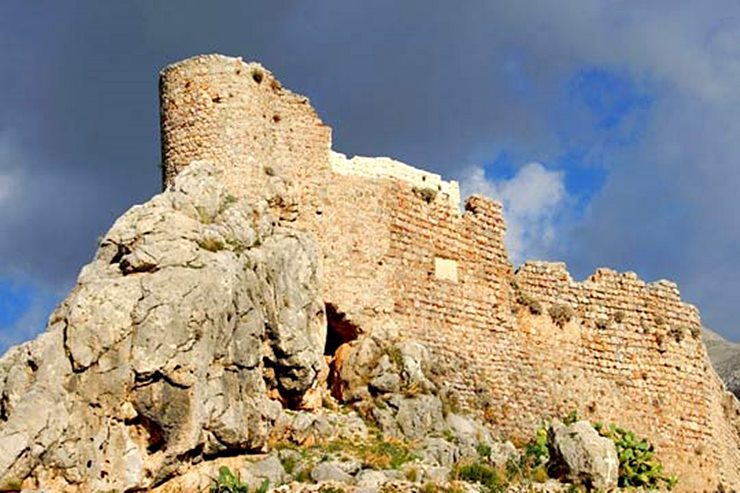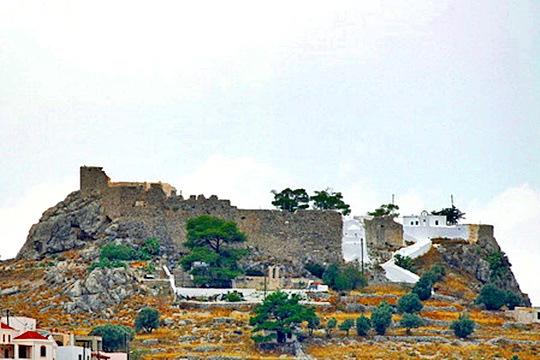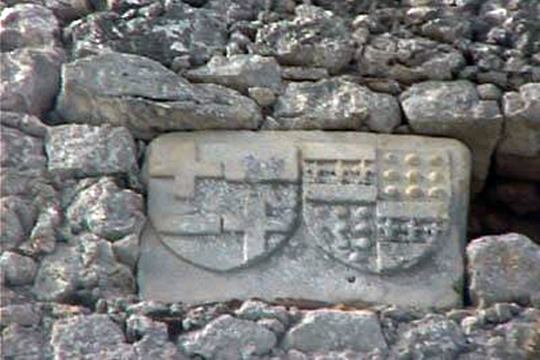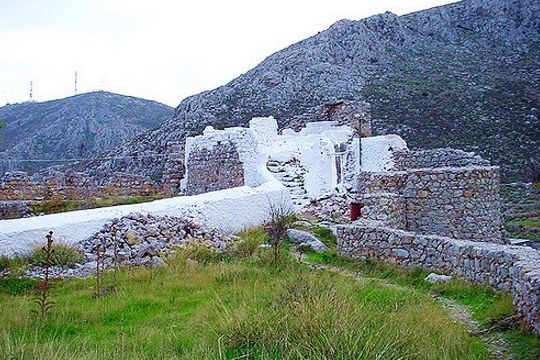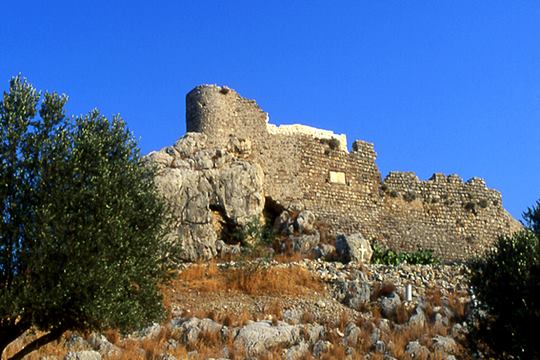Pothia, Kalymnos, Dodecanese,South Aegean
Chrysocheria Castle
| Location: |
| Between Chora and Pothia, Kalymnos island, Dodecanese |
| Region > Prefecture: | 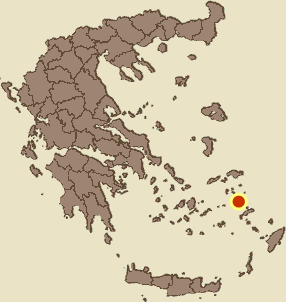 |
| South Aegean Dodecanese | |
| Municipality > Town: | |
| City of Kalymnos • Pothia | |
| Altitude: | |
| Elevation ≈ 55 m |
| Time of Construction | Origin | |
| middle 15th century | IOANNITE |
|
| Castle Type | Condition | |
| Castle |
Average
|
A medieval castle midway between Chora and Pothia. It stands on a low spur north-west to Pothia, overlooking the modern town and its harbour as well as the Pothia valley and the Kastro.
Castle Description
Text: Dr. Michael Losse, Singen (Hohentwiel), Germany (2021.06.24)General Description
Pera Kastro was built on the top of a spur, enclosing an area about 80 m north-east to south-west by 40 m. The castle’s enceinte, built of chalk quarry-stone, is irregular, following the configuration of the spur, without towers, but with flanking tower-like structures, one of those protecting the lower gate on the north-western side. There are only very sparse remains left of a barbican (most probably 15th century) on the north-western side. This barbican is not shown in most of the existing groundplans of the castle.
The enceinte is in good presevation. A number of escutcheons can still be seen in the wall, but none later than 1479. Those are the coats of arms of Fantino Querini, Adimaro Dupuy (Governor 1464-1466), Jaume de la Geltrú (Governor 1466 and 1479) and the Knights Hospitallers‘ Grandmaster Jean Bonpart de Lastic (ruled 1437-1454). De Lastic’s coat of arms is similar to that one of Grandmaster Antoine de Fluvian (ruled 1421-1437), they just differ in their colours, but the colours of Pera Kastro’s escutcheons are lost.
Inside the enceinte one can find the chapel mentioned above (Panagia tis Chrysocherias), another chapel and a cemetery.
To the east of the castle three windmills were erected; they are undated.
History of the castle
Pera Kastro, meaning “the castle on the opposite side” (as seen from Kastro, Kalymnos‘ main medieval fortification), is located on a low spur north-west to Pothia, overlooking the modern town and its harbour as well as the Pothia valley and Kastro. The castle’s second name Kastro tis Chrysoherias means „the castle of [‚the virgin Mary’ with] the golden hands’, derived from an icon in the chapel inside the castle’s enceinte (Lehmann 1985, pp. 169f).
The medieval castle has obscured traces of an ancient settlement; “abundant Mycenean sherds were found on the upper terraces below the limestone cliffs, especially on the east side, indicating an area at least 120 m. northeast to southwest by 100 m. From tombs in the torrent bed below on the east, on the south side of the road from Pothia to Sykia, about 30 LH IIIB-C vases were recovered, most of which are in the British Museum. (…) Other Mycenean and later vases in the Pothia Museum are probably also mainly from the Perakastro vicinity” (Richard Hope Simpson: Mycenean Greece. New Jersey 1981, p. 202; cf. also The Journal of Hellenic Studies [JHS] 8, 1887, p. 446).
In 1445 Fantino Querini, since 1436 the Knights Hospitallers‘ Governor of Kalymnos, Kos and Leros, tried to force the Kalymnians to support the construction of this castle. The inhabitants went to the court at Rhodes, because they didn’t agree with Querini’s purpose (cf. Tsirpanlis, Anekdota, pp. 512-13), but they lost the case, because it was a long-standing duty, that the inhabitants of the Hospitallers’ islands had to help in building and maintaining castles. So the castle was built, serving as the Governor’s residence (Loupou-Rokou 1999, p. 60).
Other Info
SourcesGerola, Giuseppe: I monumenti medioevali delle 13 Sporadi. In: Annuario Scuola Arch. Atene I, 1916, pp. 58-59, 246.
Koutellas, Michael J.: Kalymnos. History, Archaeology, Culture. From the Prehistoric Age to present times. Kalymnos 2006.
Lehmann, Ingeborg: Die Dodekanes (Griechische Inseln, vol. 3). Leichlingen bei Köln 1985, pp. 169-170.
Losse, Michael: Die Burgen und Befestigungen auf den Dodekanes-Inseln Kálymnos, Télendos und Psérimos. In: Burgenforschung – Europäisches Correspondenzblatt für interdisziplinäre Castellologie 2, 2013, Marburg (Lahn) 2014, pp. 179-216.
Losse, Michael: Die Burgen und Festungen des Johanniter-Ritterordens auf Rhódos und in der Ägäis (Griechenland) 1307-1522. (Publisher: Nünnerich-Asmus Verlag) Mainz 2017.
Loupou-Rokou, Athena-Christina: The Aegean Fortresses and Castles. Athens 1999, pp. 60-61.
Ross, Ludwig: Reisen auf den griechischen Inseln des Ägäischen Meeres. Zweiter Band. Enthaltend Andros, Syros, Mykonos, Amorgos, Astypaläa, Nisyros, Knidos, Kos, Kalymnos, Telendos, Leros, Patmos, Samos, Ikaros, DeIos, Rhenäa, Gyaros, Belbina. Stuttgart und Tübingen 1843.
Spiteri, Stephen C.: Fortresses of the Cross. Hospitaller Military Architecture (1136-1798). Valleta (Malta) 1994, pp. 217-221.
Stefanidou, Alexandra: Castles of the Knights Hospitallers. In: Anna Triposkoufi/Amalia Tsitouri (Eds.): Venetians and Knights Hospitallers. Military Architecture Networks (ARCHI-MED Pilot Action) [Hellenic Ministry of Culture, Directorate of Byzantine & Postbyzantine Monuments]. Athens 2002, pp. 184-253, here p. 248.
Zervoudaki, Eos: Kalymnos. In: Evi Melas (Ed.): Die griechischen Inseln. Köln 121994, pp. S. 258-264.
| First entry in Kastrologos: | November 2012 | Last update of info and text: | June 2021 | Last addition of photo/video: | June 2021 |
Sources
- Website Kalymnos Guide - Castles and Fortresses
- Website ΟΔΥΣΣΕΥΣ - Greek ministry of Culture Chrysocheria Castle
- Μιχαήλ Κουτελλάς, Αρχαιολόγος, Καλυμνιακά Χρονικά, Τόμος Στ’, Κάλυμνος 2005, σ. 442-445
- Article and photos 1, 4, 9 (2006) by Dr. Michael Losse
|
|
| Access |
|---|
| Approach to the monument: |
| - |
| Entrance: |
| Free access |



